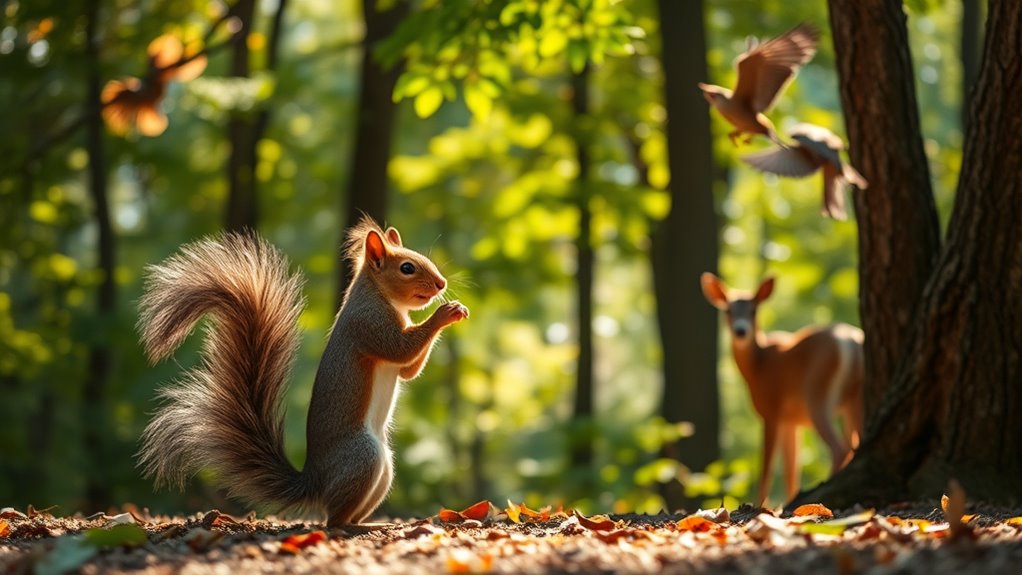Alarm calls are essential for animals to warn each other of danger. These calls vary by species and threat, helping individuals and groups react swiftly to potential risks. By alerting peers, animals foster community cohesion and improve survival chances. Some even mimic calls to gain an advantage, showing communication‘s complexity. This intricate system not only enhances individual safety but also strengthens social bonds. Discover how different species uniquely adapt their alarm calls for survival.
Key Takeaways
- Alarm calls signal danger, enhancing survival by alerting individuals and groups to potential threats in their environment.
- Different species develop unique alarm calls tailored to their specific predators, improving communication accuracy and response effectiveness.
- Some animals use mimicry, imitating alarm calls of other species to mislead rivals and gain an advantage during threats.
- Alarm calls foster group cohesion and collective vigilance, allowing social animals to coordinate swift reactions to dangers, such as predators.
- The complexity of alarm calls reflects evolved communication systems, strengthening social bonds and contributing to the stability of animal communities.

Animals often use alarm calls to signal danger, and you might be surprised by how sophisticated these vocalizations can be. When you hear a bird squawking or a monkey screeching, it’s more than just noise; it’s an essential survival tactic. These calls can vary greatly depending on the type of threat, and animals have developed intricate communication methods to inform each other of danger. It’s fascinating to think about how these alarm calls not only protect individuals but also enhance group survival.
One key aspect of alarm calls is their use of mimicry strategies. Some species have learned to imitate the alarm calls of other animals to gain an advantage. For example, certain birds may mimic the alarm calls of their predators to scare other species away. This tactic can divert attention, allowing the mimicking bird to escape unnoticed. It’s a clever evolutionary benefit that highlights the adaptability of animal communication. By mimicking a threat, these animals can manipulate the behavior of others to serve their own needs.
Moreover, the evolutionary benefits of using alarm calls extend beyond individual survival. When animals alert their peers, they create a communal awareness that fosters group cohesion. This collective vigilance helps the entire group to react swiftly to potential dangers. For instance, when a herd of gazelles spots a lion, their alarm calls can trigger an immediate response among the entire group, allowing them to scatter and evade capture. In this way, alarm calls serve as a critical tool for maintaining the balance of ecosystems, ensuring that species can thrive together.
You might also find it interesting that different species have developed unique alarm calls tailored to their environments. Some animals, like meerkats, have specific calls for different predators, allowing them to communicate precise information. This level of specificity not only showcases their intelligence but also underscores the evolutionary advantages of clear communication. The more accurately an animal can signal danger, the better its chances of survival and the survival of its group.
In essence, alarm calls are not just a series of sounds; they represent complex communication systems that have evolved over time. By using mimicry strategies and understanding the evolutionary benefits of these calls, animals can enhance their chances of survival and maintain the delicate balance of their ecosystems. Interestingly, research has shown that alarm calls can even strengthen social bonds within animal groups. So the next time you hear an animal sound, consider the potential life-saving message it might convey.
Frequently Asked Questions
Do All Animal Species Use Alarm Calls?
Not all animal species use alarm calls. While many animals rely on vocalizations for predator avoidance, others use visual communication, like body language or color changes, to signal danger. Different species have evolved distinct methods to alert others, adapting to their environments. For instance, some birds might call out, while certain reptiles may change color or posture. Overall, the strategies vary widely across the animal kingdom, showcasing nature’s diversity in communication.
How Do Alarm Calls Differ Between Species?
Alarm calls differ markedly between species, reflecting their unique environments and threats. You’ll notice species-specific vocalizations that convey specific dangers, like hawks or snakes. For instance, some birds use rapid chirps to signal nearby predators, while others may produce a low-frequency call to warn of ground threats. These alarm call variations not only help convey urgency but also provide vital information about the type of predator, enhancing survival for the entire group.
Can Humans Understand Animal Alarm Calls?
Yes, you can understand some animal alarm calls. By studying their vocal communication and alarm call syntax, researchers have deciphered meanings behind specific sounds. For instance, you might recognize that a certain call indicates a predator’s presence, while another warns of a different threat. With practice, you can learn to respond to these cues, enhancing your connection with wildlife and potentially improving your ability to protect yourself and others in nature.
What Triggers Animals to Make Alarm Calls?
When danger lurks, animals often express their concerns through alarm calls. It’s all about predator detection; they sense threats and communicate to guarantee everyone’s safety. These vocalizations not only alert others but also strengthen social bonding within their groups. So, whenever you hear an animal sound that seems urgent, know they’re looking out for each other, fostering connections while keeping an eye on the lurking predators in their environment.
Are Alarm Calls More Common in Certain Environments?
Yes, alarm calls are more common in certain environments. You’ll notice that animals in habitats with higher predator density tend to use alarm calls more frequently. This behavior reflects their adaptation to specific habitats. For instance, in dense forests or grasslands where predators are abundant, animals develop stronger communication strategies to alert each other. In contrast, in less risky environments, alarm calls might be less crucial, showcasing their habitat adaptation.
Conclusion
So, next time you hear a bird’s alarm call or a monkey’s warning cry, remember how these sounds connect species and keep them safe. It’s almost like nature’s own network, where each call echoes a shared understanding of danger. Just yesterday, you might’ve spotted a squirrel freezing in place, its ears perked up. Coincidentally, that’s the same moment a hawk soared overhead. These instinctual signals remind us of the intricate dance of survival in the wild.










